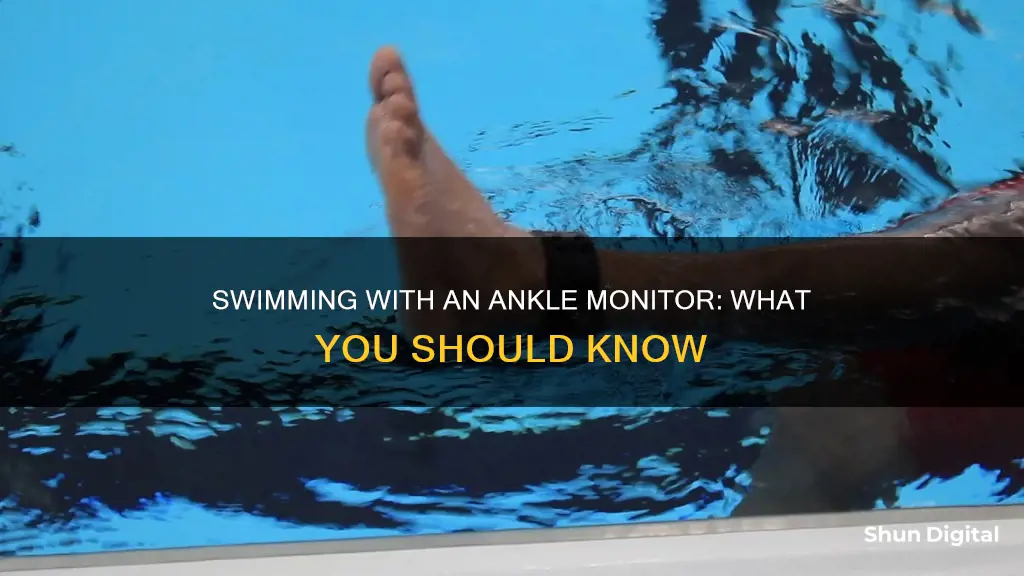
Swimming with an ankle monitor can be challenging, but it is not impossible. Ankle monitors are electronic devices used by law enforcement to track a person's location as an alternative to imprisonment. They are equipped with GPS technology, which enables officials to monitor the wearer's location and movements in real time. While the devices are waterproof, the level of water resistance varies depending on the manufacturer and model. If the signal is blocked because the monitor is submerged past a certain depth, it may register that the wearer has tampered with the device or left their designated area, prompting the authorities to be notified. To swim safely and comfortably with an ankle monitor, individuals can use waterproof tape or covers, take shorter swims, employ a pool buoy, and avoid jumping or diving. It is important to consult with a probation or parole officer for specific instructions and to comply with the terms of the monitoring program.
| Characteristics | Values |
|---|---|
| What are ankle monitors? | Electronic devices strapped around the ankle to track a person's location |
| Who uses them? | Law enforcement agencies for low-risk offenders or those on parole |
| How do they work? | Equipped with GPS technology to monitor the wearer's location and movements in real time |
| Can you swim with an ankle monitor? | Yes, with precautions |
| What are the precautions? | Use of waterproof tape, waterproof cover, shorter swims, pool buoy, and avoiding jumping or diving |
| What happens if the monitor gets wet? | If the signal is blocked due to submersion, it may register as tampering or indicate that the wearer has left their house, resulting in authorities being contacted |
| Can ankle monitors listen to conversations? | Ankle monitors primarily track physical location; while some may have a microphone, they typically cannot record or transmit audio |
What You'll Learn
- Ankle monitors are waterproof, but the level of water resistance varies
- Submerging the monitor past a certain point may be registered as tampering
- Some monitors can detect alcohol consumption by analysing sweat
- The monitor will not fall off if you avoid jumping or diving into the water
- The device can be wrapped in waterproof tape to keep it dry while swimming

Ankle monitors are waterproof, but the level of water resistance varies
Ankle monitors are typically worn by people under house arrest, on parole, or on probation. They are electronic devices strapped to the ankle to track a person's location via GPS. They are designed to be waterproof to some degree, but the level of water resistance varies depending on the specific device and the company that manufactures it.
While some ankle monitors may be waterproof up to 50 feet, allowing for activities such as snorkelling, others may have instructions advising against their use in a pool or jacuzzi. The varying levels of water resistance are due to the different states using different devices from different manufacturers. If a signal is blocked because the monitor is submerged past its designed threshold, it will be interpreted as the wearer having tampered with the device or having left their designated area, prompting the authorities to be notified.
To ensure the device remains dry and protected while swimming, it is recommended to use waterproof tape or a waterproof cover specifically designed for ankle monitors. Additionally, taking shorter swims and using a pool buoy to elevate your feet can further reduce the risk of the device getting wet. It is also important to avoid jumping or diving into the water, as the impact could cause the monitor to become loose or fall off.
The decision on whether swimming with an ankle monitor is permitted ultimately rests with the parole or correctional officer who attaches the device. They will determine the specific capabilities and limitations of the monitor and provide instructions on what activities are allowed while wearing it.
Oxygen Tip Monitor Buying Guide: Where to Purchase
You may want to see also

Submerging the monitor past a certain point may be registered as tampering
Ankle monitors are electronic devices used by law enforcement agencies to track a person's location as an alternative to imprisonment. They are typically used for low-risk offenders or those on parole. These devices are equipped with GPS technology, enabling real-time monitoring of the wearer's movements.
While some ankle monitors are waterproof and can withstand simple showers, submerging them past a certain point may be registered as tampering. Different devices have varying levels of water resistance, and while some can be waterproof up to 50 feet, allowing for snorkelling, others are not designed for use in a pool or jacuzzi.
If the ankle monitor is submerged past the point it can handle, the signal may be blocked, and this will be interpreted as the wearer tampering with the device or attempting to leave their designated area. As a result, the authorities will be alerted, and the wearer may face consequences.
To avoid this, individuals with ankle monitors who wish to swim can take precautions such as using waterproof tape or covers, taking shorter swims, employing a pool buoy, and refraining from jumping or diving. It is crucial to comply with the terms of the monitoring program and consult with the assigned probation officer for specific instructions regarding the device's capabilities and limitations.
Speakers and LCD Monitors: Can They Coexist?
You may want to see also

Some monitors can detect alcohol consumption by analysing sweat
SCRAM (Secure Continuous Remote Alcohol Monitoring) bracelets are devices that attach to an individual's ankle to monitor alcohol consumption. They are often used to monitor alcohol consumption after a driving while intoxicated (DWI) or driving under the influence (DUI) conviction. These bracelets are fitted to the individual's ankle and can be worn for 30, 60, or 90 days. They test for the presence of alcohol in the wearer's sweat every 30 minutes to an hour. This is known as transdermal alcohol concentration, and it works similarly to a breathalyser test that measures blood alcohol content (BAC).
The SCRAM bracelet is designed to be minimally disruptive to the wearer's daily life. It is built to be hypoallergenic and can be worn during showers and workouts. However, swimming with an ankle monitor is typically not allowed. While the exact reason for this restriction is unclear, it may be due to concerns about potential damage to the device or the possibility of tampering with it underwater.
The SCRAM bracelet is an innovative way to monitor alcohol consumption continuously. It can differentiate between alcohol consumption and exposure to external environmental sources of alcohol, such as alcohol-based products. Additionally, the bracelet has temperature and infrared sensors that can detect any attempts at tampering or obstruction. This feature ensures the integrity of the monitoring process and helps maintain accountability.
The data collected by the SCRAM bracelet is transmitted wirelessly to a Base Station, which then uploads it to monitoring software. This allows for a detailed pattern of alcohol consumption to be established, which can be valuable in legal settings. The bracelet's continuous monitoring also helps support long-term behaviour change and complements treatment for alcohol dependence or addiction.
In conclusion, SCRAM bracelets are an effective tool for monitoring alcohol consumption and encouraging sobriety. By analysing the wearer's sweat, the bracelet provides accurate and continuous data that can be used to support legal cases, treat alcohol dependence, and increase community safety. While swimming with an ankle monitor is typically prohibited, the bracelet is designed to accommodate daily activities and promote minimal disruption to the wearer's life.
Monitoring Bandwidth Usage: DigitalOcean's Comprehensive Guide
You may want to see also

The monitor will not fall off if you avoid jumping or diving into the water
If you're planning to swim while wearing an ankle monitor, it's important to take certain precautions to ensure that the device remains secure and undamaged. While ankle monitors are designed to be waterproof to some degree, allowing wearers to shower without issue, more vigorous aquatic activities like swimming come with their own set of considerations.
The key to maintaining the integrity of your ankle monitor while swimming is to avoid any actions that could potentially dislodge or damage the device. This includes refraining from jumping or diving into the water. The impact and force generated by such actions could cause the monitor to become loose or even fall off completely. Therefore, it is highly advisable to enter the water slowly and carefully, ensuring that the ankle monitor remains securely strapped to your ankle.
The type of swimming you intend to do also matters. For instance, if you're considering snorkelling, you should first check the specifications of your ankle monitor. Some monitors are waterproof up to 50 feet, which would allow for safe snorkelling. However, other monitors may have instructions advising against using them in a pool or jacuzzi. Submerging the monitor beyond its specified waterproof capacity could result in the signal being blocked, which would trigger a notification to the authorities that the monitor has been tampered with or that you have left your designated area.
To further ensure the security of your ankle monitor while swimming, you can employ additional measures. Waterproof tape wrapped tightly around the monitor can provide an extra layer of protection to keep it dry. Alternatively, you can purchase a waterproof cover specifically designed for ankle monitors, which will protect the device from water damage. If you're unsure about the effectiveness of these methods, you can opt for shorter swims and use a pool buoy to keep your feet and ankles elevated, minimising the risk of the device getting wet or hitting the bottom of the pool.
In summary, by avoiding jumping or diving into the water, opting for slower and more careful entrances, checking the waterproof specifications of your device, and utilising additional protective measures, you can significantly reduce the chances of your ankle monitor falling off or sustaining damage while swimming.
Resetting Your ASUS Monitor: Back to Basics
You may want to see also

The device can be wrapped in waterproof tape to keep it dry while swimming
If you need to wear an ankle monitor for legal reasons, swimming can be challenging. Ankle monitors are electronic devices that use GPS technology to track the wearer's location and movements. They are typically worn by low-risk offenders or those on parole as an alternative to imprisonment. While it is possible to swim with an ankle monitor, taking precautions to keep the device dry and protected is essential.
One effective way to keep your ankle monitor dry while swimming is to wrap it with waterproof tape. Ensure you have the appropriate type of tape that can create a tight seal around the device. Apply the tape securely so that it stays in place during your swim. This will create a barrier, protecting the device from water damage.
When applying the waterproof tape, pay close attention to detail. Start by cleaning the surface of the ankle monitor and the surrounding area to ensure that the tape adheres properly. Carefully wrap the tape around the device, making sure there are no gaps or openings that could allow water to seep in. It is important to avoid covering any buttons or indicators that could affect the functionality of the device.
To further ensure the effectiveness of the waterproof tape, consider applying multiple layers. Each layer should be wrapped smoothly and tightly, with some overlap to create a secure barrier. After you have finished swimming, carefully remove the tape and dry the device thoroughly before reapplying new tape for your next swim.
By taking these precautions and using waterproof tape, you can help keep your ankle monitor dry while swimming. Remember to follow any additional instructions or guidelines provided by the relevant authorities regarding the care and maintenance of your ankle monitor.
Sex Offenders and Ankle Monitors: Who is Tracked?
You may want to see also
Frequently asked questions
Ankle monitors are waterproof, but the level of water resistance varies depending on the model. If the monitor is submerged past a certain point, it may register that the wearer has tampered with the device or left their house, and the authorities will be contacted. To avoid this, you can wrap waterproof tape tightly around the monitor or wear a waterproof cover designed for ankle monitors.
You should check with your probation officer before going swimming. If you are allowed to swim, you should take shorter swims to reduce the risk of damaging the device. You should also avoid jumping or diving into the water, as this could cause the monitor to fall off.
Yes, a pool buoy can help elevate your feet and ankles, reducing the risk of the ankle monitor getting wet or hitting the bottom of the pool.







